Ditapis dengan
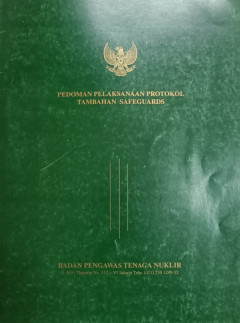
Pedoman Pelaksanaan Protokol Tambahan Safeguards
Pedoman ini dimaksud sebagai petunjuk untuk mengatur tata cara penyampaian deklarasi informasi yang dipersyaratkan protokol tambahan safeguards dengan tujuan mendeteksi kemungkinan adanya kegiatan nuklir yang tidak terdeklarasi
- Edisi
- -
- ISBN/ISSN
- -
- Deskripsi Fisik
- 73 p. : Illus. ; 29 cm
- Judul Seri
- -
- No. Panggil
- 539.7 BAP P
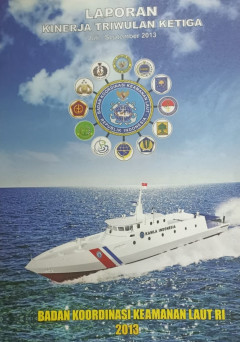
Laporan Kinerja Triwulan Ketiga Juli-September 2013 Badan Koordinasi Keamanan…
Laporan kinerja triwulan ini membahas diantaranya penyiapan kebijakan keamanan laut, koordinasi operasi keamanan laut, informasi, hukum dan kerjasama keamanan laut, dan kesekretariatan.
- Edisi
- -
- ISBN/ISSN
- -
- Deskripsi Fisik
- 112 p. : Illus. ; 29 cm
- Judul Seri
- -
- No. Panggil
- 351.1 BAD L
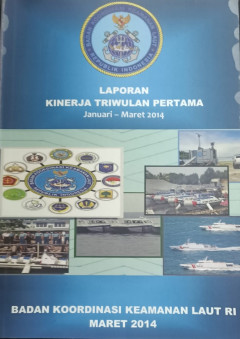
Laporan Kinerja Triwulan Pertama Januari-Maret 2014 Badan Koordinasi Keamanan…
Laporan kinerja triwulan ini memuat hasil capaian kontrak kinerja pada tahun anggaran berjalan yang terbagi ke dalam tiga periode, yakni triwulan 1,2, dan 3. Selanjutnya disusun menjadi LAKIP pada triwulan terakhir.
- Edisi
- -
- ISBN/ISSN
- -
- Deskripsi Fisik
- 53 p. : Illus. ; 29 cm
- Judul Seri
- -
- No. Panggil
- 351.1 BAD L
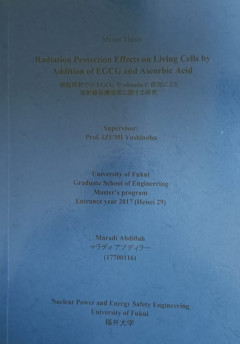
Radiation Protection Effects on Living Cells by Addition of EGCG and Ascorbic…
Radiation is different from many other things that we cone into contact in our daily lives, because we can't see it, we can't feel, we can't smell it, we can't hear it, and we can't taste it. Thus, we will know if our body are now being exposed to radiation unless we measure it using radiaiton monitoring devices. In fact, we have been exposed to natural radiation in everyday life since the time…
- Edisi
- -
- ISBN/ISSN
- -
- Deskripsi Fisik
- 73p;illus, 29cm
- Judul Seri
- -
- No. Panggil
- 614.839 ABD R
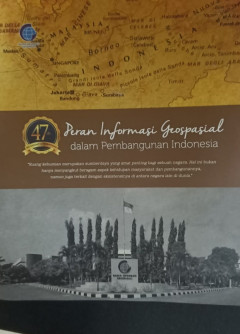
Peran Informasi Geospasial dalam Pembangunan Indonesia
Buku ini membahas sejarah kelembagaan informasi geospasial, pembentukan Bakosurtanal, transformasi Bakosurtanal menjadi BIG. Selain itu, juga membahas tentang periodisasi pembangunan informasi geospasial, pencapain program BIG, tantangan dan masa depan BIG serta pesan dan harapan tokoh BIG.
- Edisi
- -
- ISBN/ISSN
- 9786029554256
- Deskripsi Fisik
- xvi, 236 p. : illus. ; 23 cm
- Judul Seri
- -
- No. Panggil
- 527.67 KAR P

Pengantar Produksi Radioisotop dan Radiofarmaka Siklotron (PPT)
PPT ini berisi tentang definisi produksi radioisotop dan radiofarmaka, sistem keselamatan dan desain fasilitas produksi radioisotop dan radiofarmaka. Selain itu, tentang potensi bahaya radiasi pada fasilitas produksi radioisotop dan radiofarmaka, penanganan keadaan darurat & dekontaminasi. Pokok pembahasan lain menjelaskan tentang pengelolaan limbah radioaktif. PPT dipresentasikan dalam acar…
- Edisi
- -
- ISBN/ISSN
- -
- Deskripsi Fisik
- 52p. : Illus. pdf
- Judul Seri
- -
- No. Panggil
- 604 IND P
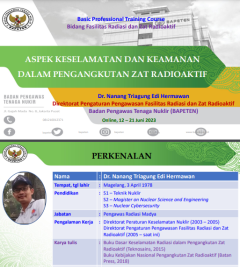
Aspek Keselamatan dan Keamanan Dalam Pengangkutan Zat Radioaktif (PPT)
PPT ini tentang menjelaskan dan menerapkan aspek keselamatan dan keamanan dalam pengangkutan zat radioaktif Daftar Isi: Pendahuluan Konsep Keselamatan Radiasi dlm Pengangkutan Konsep Keamanan dlm Pengangkutan Antarmuka aspek Keselamatan dan Keamanan PPT dipresentasikan dalam acara Pelatihan BPTC FRZR / Basic Profesional Training Course Fasilitas Radiasi dan Zat Radioaktif 13-21 Juni 2…
- Edisi
- -
- ISBN/ISSN
- -
- Deskripsi Fisik
- -
- Judul Seri
- 60 p. : Illus. pdf
- No. Panggil
- 348 TRI A
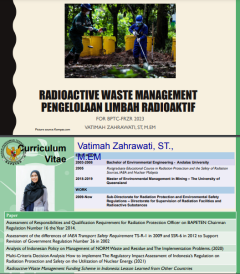
Pengelolaan Limbah Radioaktif (PPT)
Sumber radioaktif yang sebelumnya bekas digunakan untuk medik, namun karena kurangnya kepedulian terhadap bahaya radiasi, masyarakat lokal mengambil sumber tersebut dari fasilitas medik yang sudah ditinggalkan. Sumber radioaktif tersebut dibuka dan isi radioaktif tersebar ke area yang cukup luas. Daftar isi PPT: Introduction Regulations in Indonesia Radioactive waste classification Peng…
- Edisi
- -
- ISBN/ISSN
- -
- Deskripsi Fisik
- 54 p. : Illus, pdf
- Judul Seri
- -
- No. Panggil
- 604 ZAh P

Modul Petunjuk Teknis Penyusunan Proposal Inisiatif Baru
Modul ini dibuat dengan tujuan untuk menjadi panduan praktis bagi kementarian/lembaga dalam penyusunan inisiatif baru, meningkatkan kualitas proposal inisiatif baru yang disusun oleh lemabaga/kementerian, sebagai panduan dalam penetapan usulan inisiatif baru.
- Edisi
- -
- ISBN/ISSN
- -
- Deskripsi Fisik
- 30p. : illus. ; 24 cm
- Judul Seri
- -
- No. Panggil
- 352.1 BAP M

Rencana Strategis Badan Pengawas Tenaga Nuklir
Berisi Rencana Strategis BAPETEN Tahun 2001 – 2005 yaitu: 1. Mengkaji, mengembangkan dan merumuskan peraturan atau mengadopsi peraturan. 2. Meningkatkan metode/sistem perizinan yang berkualitas serta melaksanakan proses perizinan termasuk verifikasi, sertifikasi dan akreditasi secara transparan. 3. Melaksanakan inspeksi keselamatan nuklir yang efektif dan efisien serta menyempurnakan metode/…
- Edisi
- -
- ISBN/ISSN
- -
- Deskripsi Fisik
- 23 p. : Illus. ; 29 cm
- Judul Seri
- Rakornas Ristek XIX, Surabaya, 10-12 Agustus 2011
- No. Panggil
- 352 RIS R
 Karya Umum
Karya Umum  Filsafat
Filsafat  Agama
Agama  Ilmu-ilmu Sosial
Ilmu-ilmu Sosial  Bahasa
Bahasa  Ilmu-ilmu Murni
Ilmu-ilmu Murni  Ilmu-ilmu Terapan
Ilmu-ilmu Terapan  Kesenian, Hiburan, dan Olahraga
Kesenian, Hiburan, dan Olahraga  Kesusastraan
Kesusastraan  Geografi dan Sejarah
Geografi dan Sejarah